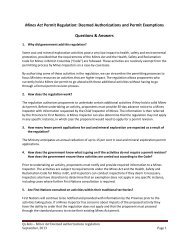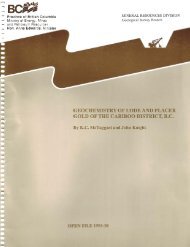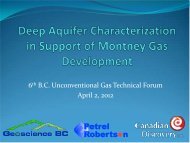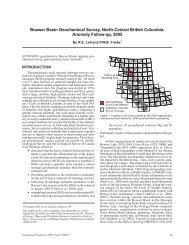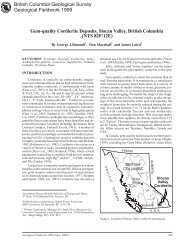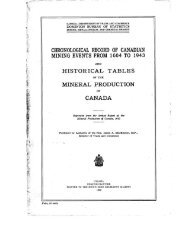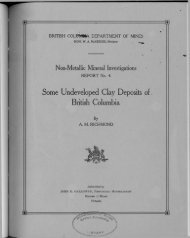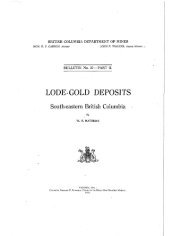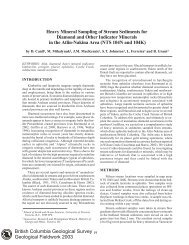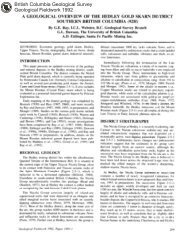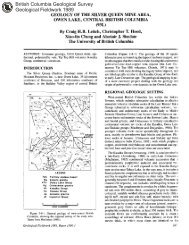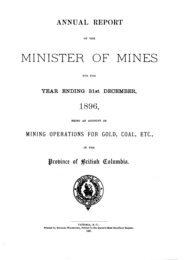PDF version - Ministry of Energy, Mines and Natural Gas
PDF version - Ministry of Energy, Mines and Natural Gas
PDF version - Ministry of Energy, Mines and Natural Gas
Create successful ePaper yourself
Turn your PDF publications into a flip-book with our unique Google optimized e-Paper software.
Mineral Occurrence<br />
DEPOSIT<br />
CHARACTER<br />
Vein 01<br />
CODE MINFILE DEFINITION<br />
Occurrences in which mineralization occurs within one or more simple or complex veins, or vein sets which may be<br />
associated with fault or shear zones.<br />
Stockwork 02 Occurrences in which mineralization occurs within a network <strong>of</strong> veinlets in the country rock.<br />
Breccia 03<br />
Mineral occurrences hosted <strong>and</strong>/or controlled by the angular, broken rock fragments held together by a mineral<br />
cement or in a fine-grained matrix. The breccia may be sedimentary, igneous or tectonic in origin.<br />
Pipe 04<br />
Unconsolidated 05<br />
Podiform 06<br />
Layered 07<br />
Stratabound 08<br />
Stratiform 09<br />
Mineralization in pipes which are generally funnel shaped or cylindrical,, particularly mineralized breccia pipes,<br />
diatremes, etc.<br />
Occurrences within material whose particles are not cemented together. May occur at surface or at depth but is<br />
usually assumed to be surficial material.<br />
Mineralization in a lenticular or rodlike shape with either diffuse or sharp boundaries. May vary from a few centimetres<br />
to tens <strong>of</strong> metres in size.<br />
Mineralization within a tabular succession with different components <strong>of</strong> igneous, sedimentary or metamorphic rocks<br />
which can be identified by mineralogical, textural or structural criteria.<br />
General term for mineralization confined by physical or chemical controls to specific stratigraphic units. Such deposits<br />
can include veins, lenses, layers, etc. which may or may not be transgressive relative to the enclosing stratigraphy.<br />
Specific term used for mineralization which is generally sheet-like in form <strong>and</strong> concordant to layering in enclosing<br />
rocks. Generally applied to deposits such as sedimentary exhalative (SEDEX) <strong>and</strong> volcanogenic massive sulphide<br />
(VMS) deposits.<br />
Concordant 10 Mineralization which is structurally conformable with the major mineralogical textural or structural fabric <strong>of</strong> the hostrock.<br />
Discordant 11 Mineral occurrences which are not parallel to the major mineralogical, textural or structural fabric <strong>of</strong> the hostrock.<br />
Massive 12 Mineralization which constitutes a larger percentage <strong>of</strong> the rock volume than the matrix or gangue minerals.<br />
Disseminated 13 Mineralization which occurs as scattered grains in the hostrock. There is no genetic connotation.<br />
Shear 14<br />
A tabular zone <strong>of</strong> rock that has been crushed <strong>and</strong> brecciated by many parallel fractures due to shear strain. Such an<br />
area is <strong>of</strong>ten mineralized by ore-forming solutions.<br />
Unknown ** Insufficient information to allow classification.<br />
4.5 DEPOSIT CLASSIFICATION(*) (R07) (E07)<br />
Deposit classification is a general interpretation <strong>of</strong> the origin <strong>of</strong> an occurrence based on the best<br />
available geological data. The database will accept up to four classifications for any given occurrence.<br />
This field is m<strong>and</strong>atory <strong>and</strong> at least one classification must be assigned. The coding <strong>of</strong> deposit<br />
classification should be ranked, that is, provide the order in which the classifications are to be entered.<br />
The ranked order will be reflected in the printout.<br />
A genetic description should be incorporated in the Capsule Geology <strong>and</strong> should indicate the geological<br />
evidence for the interpretations.<br />
DEPOSIT<br />
CLASSIFICATION<br />
Replacement 01<br />
Magmatic 02<br />
CODE MINFILE DEFINITION<br />
Deposits form by a solution <strong>and</strong> deposition mechanism by which new (ore) minerals grow <strong>and</strong> replace existing<br />
minerals. Usually used in the context <strong>of</strong> ore minerals replacing carbonate minerals or other soluble rock.<br />
Mineralization is directly related to a crystallization process in magma, exclusive <strong>of</strong> pegmatites. The deposits may<br />
constitute the entire rock mass, form a compositional layer, or occur as disseminated minerals in an igneous rock.<br />
file:///C|/HardcopyManual/05_codemino.htm (5 <strong>of</strong> 10)2007-09-20 4:09:05 PM



